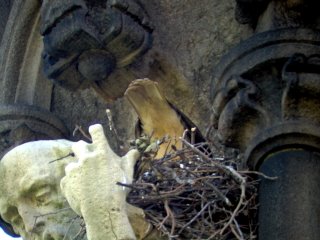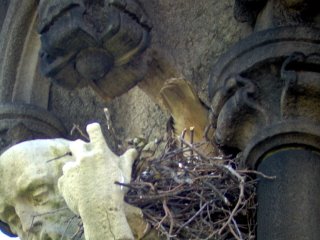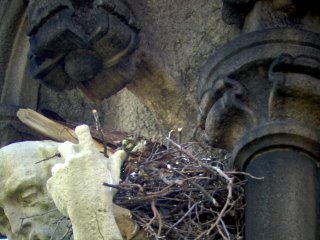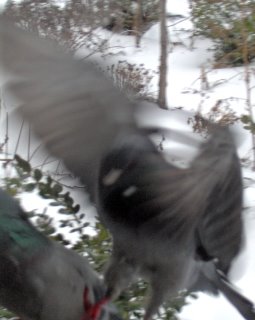
WAS THIS POSITION TAKEN TO FEED
THE SAME EYASS AS POSITIONS 1 OR 2 ?
COULD THERE BE A NUMBER 4?
OR IS SOMEONE JUST FIDGETY?

FEEDING POSITION 1

FEEDING POSITION 2

FEEDING POSITION 3

HUNTRESS MOM

PREY AVAILABILITY
On May 22nd when I saw Divine Mom take her positions to feed the eyasses. It looked to me as if she took at least three solid positions and so I was suspicious there was a third eyass we hadn't seen yet. Now I'll confess there was also a possible fourth position. It just seems like that would be pushing it.
Secondly, ten years ago when I regularly frequented The Cathedral Church of St. John the Divine there were hundreds of pigeons who made their living on it's front steps. That is certainly no longer the case. In fact for such a perfect pigeon area, the population looks downright sparse.
And third I wondered why Divine Mom seems to be doing so much more hunting while the nest is full than Charlotte did or Lola is reported to have done.
John Blakeman, who has been sharing his hawk expertise with the Hawk Watchers of New York City for some years now, has taken on the questions and shares his opinions.
Here is what John Blakeman has to say.
Donna,
A fourth eyass would, indeed, be remarkable. Frankly, to those of us who've studied red-tails for a long time, three eyasses is noteworthy. Three-eyass nests are known, but uncommon except in certain areas in the West, especially in California, where there are large numbers of vulnerable ground squirrels in the first half of the summer. East of the Rockies, three-eyass nests are uncommon. I've never learned of a four-eyass nest anywhere in the East or Midwest. There just doesn't seem to be enough prey to produce or support four eyasses.
But your observation regarding a decline in pigeons in the area of the church is interesting. I'm certain that red-tails would easily pluck pigeons squabs off exposed nests. And pigeon nests are generally very exposed, especially in areas where there has been no raptor predation. Could the present success of the St. John the Divine nest be a result of new exploitation of a naive pigeon population? As with all red-tail nests, It sure would be interesting to get an accurate listing of prey being brought in. The frequencies and ratios of pigeons/squabs/rats/rat pups/and squirrels at each nest would really flesh out the prey availability and capture questions. If you are studying grazers, the kinds and amounts of grass species being consumed each day tells everything about the population of the grazers. Prey capture data for the red-tails would fill in the giant holes of understanding we have for them in NYC.
I can't explain the more frequent hunting by the Divine female, compared to the CP birds. This may reflect, however, the presence of three (or four?) eyasses. One or two eyasses can be adequately fed by the efforts of just the male, with the female hanging around and acting protectively motherly. But a tiercel, the smaller of the two sexes, just may not be able to capture sufficient prey for three growing eyasses. Mom may have to take up the slack. There is a giant tipping point between two and three eyasses. Two can be easily fed. Three? It's tough and everything has to go just right, including increased hunting by the mother.
That may (or may not) be the explanation.
I can't see that the prey up at St. John the Divine could be significantly smaller. Smaller prey would be the natural wild sustenance food of rural red-tails, the gerbil-sized common meadow vole. But Manhattan red-tails don't have many (or any) of these to consume. The cathedral hawks have to be chasing the same species being taken down in Central Park -- primarily pigeons and rats, with perhaps an errant squirrel tossed in.
All of these are relatively large prey animals. Rural red-tails must rely on the little voles, so they have to make a lot more captures to yield the same daily protein content. The NYC adults are telling their rural relatives that eating in NYC is really good, with really big portions. But catching a pigeon just isn't as easy as plucking off a near-sighted little vole. The NYC red-tails have become remarkably adept and efficient hunters. Their rural kindred would be amazed.
--John Blakeman
No comments:
Post a Comment